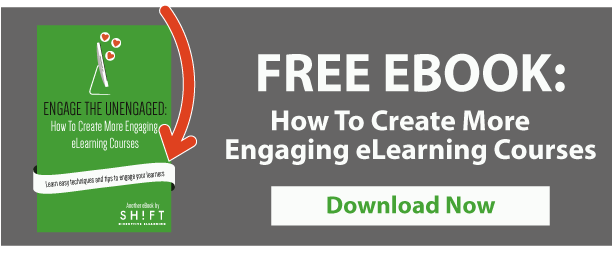
In terms of eLearning, what learners need most today is quality eLearning material. After all, more is not always better. So, instead of drowning students in a sea of content, keep your writing brief, compelling, engaging and clear. This will definitely resonate with your audience.
In this post we've compelled the best techniques and tips that will help eLearning developers to improve their eLearning writing— advice based on the medium of eLearning and with learning design in mind.
Helpful tips for writing great content for your eLearning courses:
1. First of all, focus on your audience – make an important promise since the beginning (with your headline and introduction) that tells the learners what’s in it for them. Never allow learners to question why they are in your course.
2. Plan, they write. Before you begin, think: who is the audience, what is the purpose of the message and how will the learner use the information.
3. It’s crucial to plan the structure of an eLearning course. List the topics which need to be covered. Separate those topics and plan what you want to cover on each screen.
4. Most learners only skim on-screen text so keep it lively and relevant to the learner. A simple idea to make the course scannable is by adding subheadings for each main idea. That means that learners will be able to glance at the subheadings and pick out the main ideas.
5. Remember that writing for the screen is very different from writing for the page. On the page words, have the main purpose of communicating. On-screen, images should do that job.
6. Use active voice. The active voice is more direct and engaging. Writing in the active voice gives energy and movement to your content, which will keep your learners interested all way long.
7. As an Instructional Designer, your writing style needs to adapt to what you are creating and what the end product is supposed to be.
8. Take out all the industry speak and make simple word choices. Learn how to adjust your “speak” so what you that anyone taking the course can understand it quickly and easily.
9. Be very specific. Remember students are learning at their own pace and do not have an instructor in front of them. Sometimes you have to further explain something that someone would normally experience if they had instructor-lead training.
10. Use bullet points. This is one time when bullet points are your friend! Other types of extremely clear formatting work as well, but the idea is to break up the text into manageable amounts.
11. Consistency. Make sure things like e-mail or email are the same throughout the course. By creating standards, learners will develop a feeling of familiarity when viewing the courses. Check out this Writing Style Guide Template from ELearning Uncovered.
12. Organize the content. Outline your course with relevant and outstanding titles, breaking the course into sections as needed. This gives learners a feel for the course and provides logical breaking points in the training.
13. Edit, improve, edit. Recheck your writing to improve and edit until it is perfect.
14. Variety is very important. You can go beyond bullet point slides and vary the rhythm of your text. Ask questions, mix up the structure – use scenarios, give examples, tell a story.
15. As always, it is best to put yourself in the shoes of the learner. Read the text aloud to yourself and decide if it is working well with the elements on the screen. If you are not able to get it through smoothly, your learners may have difficulties following it too.
16. Say more, with less. Trim the fat! Or even better, if a picture is worth a thousand words, use it. When going through the editing process, try to cut out words or even whole sentences that are not necessary. You’d be surprised at how much more concise you can be!
17. Provide an “easy-read” for the learners—one that is understandable on the first read-through to avoid losing them. Limiting the amount of words usually leads to tighter, clearer writing because authors need to get to the point quickly and must remove extraneous material.
18. Know your learners so well you can get inside their heads. Try to understand as much as you can about them. Then try to make your eLearning course a conversation with this “persona”.
19. Use jargon only when necessary. Most real people don’t speak in jargon, they speak in plain English. If you’re stuffing your course with manual-speak, it’s not going to read naturally. Instead, it might make things more confusing for your learner. Again, reading aloud will help.
20. Consider adding personality. Sometimes it is appropriate to add humor and personality toyour text. This can make an eLearning course a friendlier experience.
21. Make sure the language and detail is authentic. If you’re in new territory, talk to subject matter experts and do the research to make sure you’re comfortable with the dialogue and patterns of speech.
22. Be mindful of grammar and spelling. When you deliver a course, you want it to be of the highest quality. Obviously this means that we want both grammar and spelling to be as perfect as it possibly can. Your credibility takes a hit when you publish typos on your courses.
23. Use words learners can picture. Use energetic and descriptive words as much as possible.
24. Descriptive headlines and titles: headlines and titles should tell the learner what the course or module is about. Some people like to use humor, while others prefer to play it straight. It doesn’t matter, as long as readers know what to expect. Readers want to know what’s in it for them. A good title will tell them.
25. Personalize text. Use a conversational writing style that relies on first- and second-person language (using “you,” “I,” “our,” and “we.)
26. Promise it will be quick: Your text needs to communicate in a second that the entire experience of taking the lesson will be something they can do quickly and painlessly. The way you name your lessons can help you out. Short sentences and paragraphs work great also. No one wants to read the Great American Novel in your courses.
27. Write to express not impress. Don’t try to impress with your choice of words. It can annoy your learners if you do this. Keep the language simple so that your learners can focus only on learning the content.
28. Use text, but do it responsibly. Keep it to no more than six lines per screen.
29. Break it up. If you want your eLearning content to be user friendly, you have to make it digestible. Format definitely improves readability.
30. The devil is in the details. Readability is influenced by many factors. White space is one. Typography is another. The size and type of font you select has an effect on how your readers takes in your content.
Having excellent writing on your eLearning courses is one of the easiest ways to grab the attention of learners (and keep them coming back for more). These are just some tips that we've collected from the experts at Training Mag. If you want to know more, check out these article.









